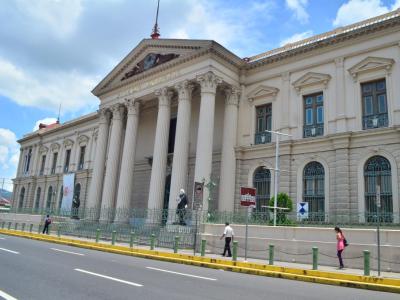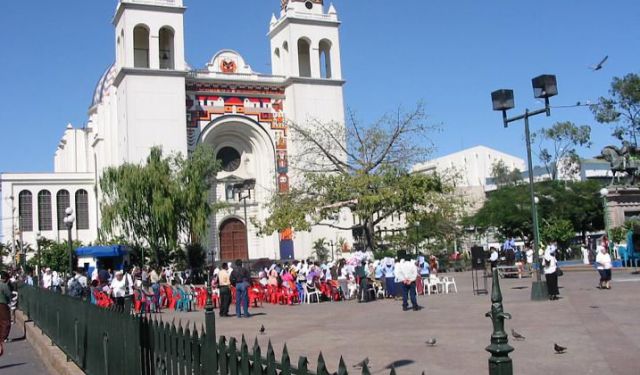El Palacio Nacional (National Palace of El Salvador), San Salvador
The National Palace of El Salvador, located in the heart of San Salvador, stands as a monument of immense historical significance. Once serving as the seat of the country's government, it ceased this function after being damaged by earthquakes. Despite this, the palace remains an important historical site and is now open to tourists. Built in the early 20th century, its architectural style is a blend of Italian design with neo-Renaissance elements, reflecting European influences. The opulent interior, adorned with luxurious decorations, earned it the status of a national monument in 1974, making it one of the most representative buildings in the country.
The current structure replaced the old National Palace, which was built between 1866 and 1870 but was destroyed by fire in 1889. Construction of the new palace began in 1905 and was completed in 1911 under the supervision of engineer José Emilio Alcaine and foreman Pascasio González Erazo. To fund the construction, legislation was enacted to collect one colón for every quintal of coffee exported. The materials for the palace were imported from various European countries, including Germany, Italy, and Belgium, showcasing a rich array of imported craftsmanship and materials.
The National Palace's interior is notable for its four main rooms and 101 secondary rooms, each main room distinguished by a unique color. The Red Room (Salon Rojo) is used for receptions by the Salvadoran Foreign Ministry and ceremonial presentations of ambassadors' credentials, a tradition since the administration of General Maximiliano Hernández Martínez. The Yellow Room (Salon Amarillo) serves as the office for the President of the Republic. The Pink Room (Salon Rosado) originally housed the Supreme Court and later the Ministry of Defense.
The Blue Room (Salon Azul) was the meeting place of the Legislature of El Salvador from 1906, notable for its classical architecture with Ionian, Corinthian, and Roman elements. This room, now called the Salvadoran Parliament, commemorates its historical purpose and was declared a National Historic Landmark in 1974.
Today, the National Palace of El Salvador stands not only as a testament to the country's rich history but also as a symbol of its architectural and cultural heritage. Visitors can explore its grand halls and intricate designs, gaining insight into the historical and political legacy of El Salvador.
The current structure replaced the old National Palace, which was built between 1866 and 1870 but was destroyed by fire in 1889. Construction of the new palace began in 1905 and was completed in 1911 under the supervision of engineer José Emilio Alcaine and foreman Pascasio González Erazo. To fund the construction, legislation was enacted to collect one colón for every quintal of coffee exported. The materials for the palace were imported from various European countries, including Germany, Italy, and Belgium, showcasing a rich array of imported craftsmanship and materials.
The National Palace's interior is notable for its four main rooms and 101 secondary rooms, each main room distinguished by a unique color. The Red Room (Salon Rojo) is used for receptions by the Salvadoran Foreign Ministry and ceremonial presentations of ambassadors' credentials, a tradition since the administration of General Maximiliano Hernández Martínez. The Yellow Room (Salon Amarillo) serves as the office for the President of the Republic. The Pink Room (Salon Rosado) originally housed the Supreme Court and later the Ministry of Defense.
The Blue Room (Salon Azul) was the meeting place of the Legislature of El Salvador from 1906, notable for its classical architecture with Ionian, Corinthian, and Roman elements. This room, now called the Salvadoran Parliament, commemorates its historical purpose and was declared a National Historic Landmark in 1974.
Today, the National Palace of El Salvador stands not only as a testament to the country's rich history but also as a symbol of its architectural and cultural heritage. Visitors can explore its grand halls and intricate designs, gaining insight into the historical and political legacy of El Salvador.
Want to visit this sight? Check out these Self-Guided Walking Tours in San Salvador. Alternatively, you can download the mobile app "GPSmyCity: Walks in 1K+ Cities" from Apple App Store or Google Play Store. The app turns your mobile device to a personal tour guide and it works offline, so no data plan is needed when traveling abroad.
El Palacio Nacional (National Palace of El Salvador) on Map
Sight Name: El Palacio Nacional (National Palace of El Salvador)
Sight Location: San Salvador, El Salvador (See walking tours in San Salvador)
Sight Type: Attraction/Landmark
Guide(s) Containing This Sight:
Sight Location: San Salvador, El Salvador (See walking tours in San Salvador)
Sight Type: Attraction/Landmark
Guide(s) Containing This Sight:
Walking Tours in San Salvador, El Salvador
Create Your Own Walk in San Salvador
Creating your own self-guided walk in San Salvador is easy and fun. Choose the city attractions that you want to see and a walk route map will be created just for you. You can even set your hotel as the start point of the walk.
San Salvador Introduction Walking Tour
The vibrant capital of El Salvador, San Salvador, weaves a colorful tapestry of history and culture as a testament to resilience and rebirth amid natural adversities. The city's name, translating to 'Holy Savior,' traces its origins to the Spanish conquest, epitomizing the deep religious roots instilled by the colonizers.
The region's history, however, dates back to the... view more
Tour Duration: 2 Hour(s)
Travel Distance: 2.7 Km or 1.7 Miles
The region's history, however, dates back to the... view more
Tour Duration: 2 Hour(s)
Travel Distance: 2.7 Km or 1.7 Miles




